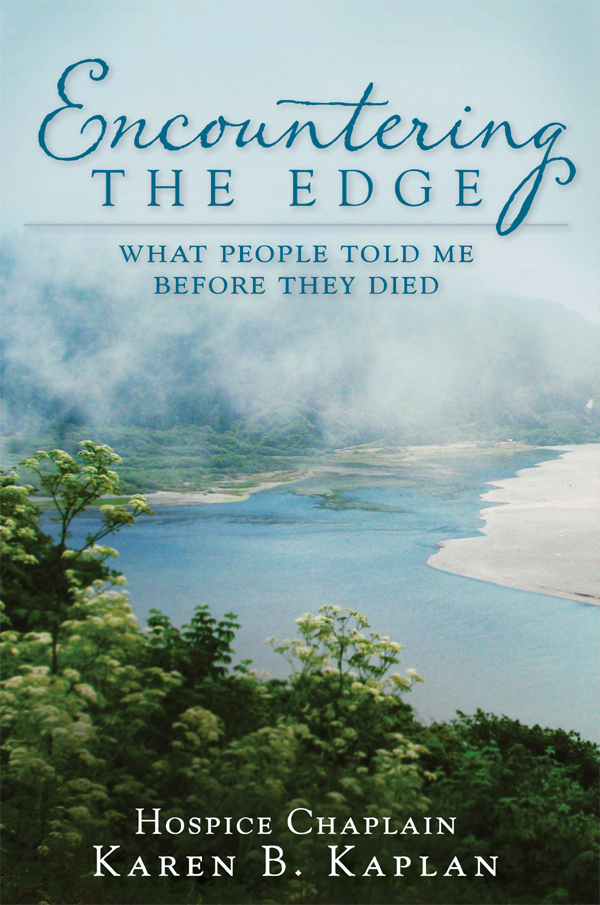Sharing The Hospice Experience
Despite the fact that none of us gets out of this world alive, generally speaking we’re uncomfortable with the concepts of death and dying. In her book, Encountering the Edge: What People Told Me Before They Died, Karen Kaplan, an ordained rabbi and board certified chaplain, demystifies the process by talking about her experiences with hospice clients of all ages and denominations. Listening as they share their stories, their hopes and their fears, she offers the powerful gift of being heard, with warmth, gentle humor and deep compassion. Below is an excerpt:
_________________________
As you accompany me to my patients, you may find yourself throwing various assumptions overboard. Such as when I sing to them, you might think I only sing sweet and religious songs like “Swing Low Sweet Chariot,” or “Kumbaya, My Lord,” or something based on the Psalms such as “May the Words of My Mouth.” Sam, twenty-eight years old and formerly a policeman, was one of the youngest residents in a nursing home relatively near my office; he was there on account of a disease that was stealthily stealing his motor abilities. Almost every time I stopped in, he gave me a broad delighted smile. But he decidedly did not want to hear a “girlie” thing like a hymn, though his mother did. She visited him at the nursing home practically every day to patiently feed him lunch served along with her cheery and loving talk. I often saw her during my weekly visits, and because she found my hymns soothing, I sang them for her benefit when she was around. She kept requesting them every time our visits coincided, although she had a thing or two to say to God due to the disease that was destroying her son. Sam, as I implied before, was not ambivalent about religion. He simply was not on board with it, so I tried to think of something nonreligious to sing. I had recently found out that one of the things Sam missed a lot at the nursing home was beer. Since I could not quickly arrange to have it made available (this would have required a doctor’s order), I thought a song about such beverages might raise his spirits at least in part. So I energetically sang “What Do You Do with a Drunken Sailor,” “Ninety-Nine Bottles of Beer,” and “In Heaven There Is No Beer.” All of these elicited his distinctive lingering smile. On subsequent visits, when I asked if he wanted to hear these again, he formed an even longer-lasting smile and said, “Sure!” Even his mom allowed herself a grin. At later visits when he could no longer indicate what he wanted to hear, his smile acted as confirmation.
One of Sam’s dying wishes was to get a tattoo showing his police rank and years of service. Given his condition, the procedure would have been painful, but his response was, in his soft high-pitched voice, “I’m tough.” Unfortunately, this was complicated to arrange. For one thing, he was not strong enough to leave the nursing home to appear at the tattoo parlor. There was some talk of getting a tattoo artist to make a house call, but by then, Sam was too weak to endure getting the tattoo. Soon after his disease had progressed to that stage, my husband Steve and I saw a performance of Hawaiian hula dancers, and I noticed that they had tattoos—not the kind we typically think of with pictures of hearts and arrows and letters, but of geometric shapes. One of the Hawaiian performers explained that their tattoos signify such matters as family connections and position in the social hierarchy. The higher the rank, the more elaborate and more numerous the designs. I thought of Sam, who wanted us to read his epitaph on his skin, proclaiming who he was and what he had achieved.
_________________________
Ordained in 1992, Karen was among the first 200 female rabbis worldwide. In 2007 she became a board certified chaplain and served hospices for seven years. Her goal in writing Encountering The Edge: What People Told Me Before They Died, and her blog, offbeat compassion, is to provide a gentle entree to a forbidding yet mesmerizing subject. The book is available on Amazon in softcover, a Kindle version, and now as an audiobook, which can also be purchased on audible.com.


